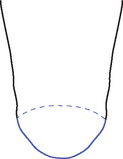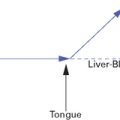 TONGUE-BODY SHAPE
TONGUE-BODY SHAPE
THIN
A Thin tongue is actually not common, probably because Dampness and Phlegm, which make the tongue Swollen, are such common and predominant pathogenic factors. As they tend to make the tongue Swollen, even if the patient has a concurrent severe Blood deficiency, this would not manifest on the tongue-body shape. In my practice, for example, out of 2378 patients, less than 2% have a Thin tongue while nearly 37% have a Swollen tongue.
SWOLLEN
The size of the tongue body has to be related to the size of the head of the person: what might be “Swollen” for someone may be normal for another. (See Plate 25.1 on p. P23.) As the thickness of the tongue body depends on the supply of fluids and Blood, a Swollen tongue body indicates an accumulation of fluids, which may be Dampness, Phlegm or oedema. Thus a swelling of the tongue always indicates a Full condition and particularly one characterized by Dampness or Phlegm. Although Dampness and Phlegm usually arise from a Qi or a Yang deficiency, the swelling of the tongue body reflects the Full condition created by these two pathogenic factors.
PARTIALLY SWOLLEN
A swelling on the sides in the Liver area (Fig. 25.1) is very common and it usually indicates Liver-Heat; it is nearly always associated with a Red colour in the same area.
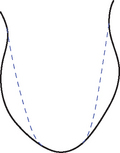
Fig. 25.1 Swelling in the Liver area
A swelling on the sides in the chest/breast area (Fig. 25.2) generally indicates either retention of Phlegm in the chest or breast or Lung-Qi deficiency.
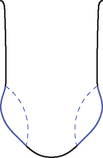
Fig. 25.2 Swelling in the chest/breast area
A swelling of the tip of the tongue (Fig. 25.3), usually associated with a Red colour, is very common and it indicates Heart-Heat or Heart-Fire deriving from severe emotional problems.
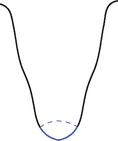
Fig. 25.3 Swelling of the tip of the tongue
A swelling of the front third of the tongue (Fig. 25.4) indicates retention of Phlegm in the Lungs. (See Plate 25.2 on p. P23.)
STIFF
A Stiff tongue lacks the normal suppleness and flexibility. It looks hard and stiff. It indicates internal Wind, Blood stasis or severe Yin deficiency. (See Plate 25.3 on p. P24.)
FLACCID
A flaccid tongue is flabby and, in severe cases, it has a crumpled look. It always indicates lack of Body Fluids or Blood.
CRACKED
Generally, cracks on the surface of the tongue indicate Yin deficiency or the tendency to it but, though this is the most common cause, there are others such as Dampness or deficiency of the Original Qi. Horizontal cracks (Fig. 25.5) indicate Yin deficiency, usually of the Stomach or Kidneys, or both, and they are more commonly seen in the elderly.
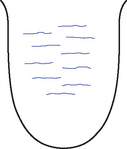
Fig. 25.5 Horizontal cracks
Irregular cracks (Fig. 25.6) usually indicate Stomach-Yin deficiency or the tendency to it. (See Plate 25.4 on p. P24.)
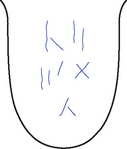
Fig. 25.6 Irregular cracks
A central short crack in the midline of the tongue (Fig. 25.7) is very common and it indicates Stomach-Yin deficiency, or the tendency to it. (See Plate 25.5 on p. P24.)
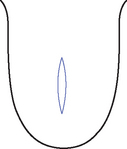
Fig. 25.7 Stomach crack
A central long crack in the midline of the tongue (Fig. 25.8) is also common and its clinical significance depends on its depth and on the colour of the tongue body, especially the tip. (See Plates 25.6 and 25.7 on p. P24.)

Fig. 25.8 Heart crack
If the Heart crack is shallow and the body colour normal, this simply indicates a constitutional tendency to Heart patterns and it does not have a specific clinical significance. However, if a person has such a crack, any emotional stress from which he or she might suffer will have deeper repercussions than for someone without a Heart crack. According to Dr J. H. F. Shen, a shallow Heart crack on a normal body colour may also indicate heart disease in the parents or even grandparents.
Short, transverse cracks on the sides (Fig. 25.9) are a clear sign of Spleen-Yin deficiency. This is not common and is not a common condition often described among the Spleen patterns; such cracks are the easiest way of identifying such a pattern (see Plate 25.5 on p. P24.)
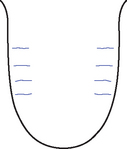
Fig. 25.9 Transverse Spleen cracks
Short, transverse cracks behind the tip in the Lung area (Fig. 25.10) usually indicate a past Lung pathology such as pneumonia, whooping cough or repeatedlung infections during childhood. As such cracks reflect past pathologies, they do not have a major clinical significance.

Fig. 25.10 Lung cracks
An extremely deep midline crack with other small cracks branching out from it (Fig. 25.11) is usually seen in a Red tongue without coating. It indicates a severe Kidney-Yin deficiency with Empty-Heat in the Kidneys and Heart.
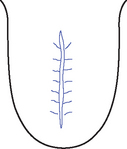
Fig. 25.11 Deep midline cracks with small cracks
DEVIATED
The Deviated tongue deviates to one side when extended (Fig. 25.12).
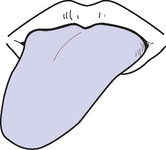
Fig. 25.12 Deviated tongue
QUIVERING
The Quivering tongue trembles rapidly and with small-amplitude movements as it is extended. The most common clinical significance of a Quivering tongue in chronic conditions is Spleen-Qi or Spleen-Yang deficiency.
TOOTHMARKED
The tongue with teethmarks (Fig. 25.13) indicates chronic Spleen-Qi deficiency, but since a tongue with a normal body shape can have teethmarks, do not assume that the presence of teethmarks necess-arily means it is Swollen. (See Plate 25.8 on p. P24.)
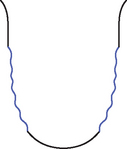
Fig. 25.13 Tongue with teethmarks
Box 25.1 summarizes the patterns underlying different tongue-body shapes.

